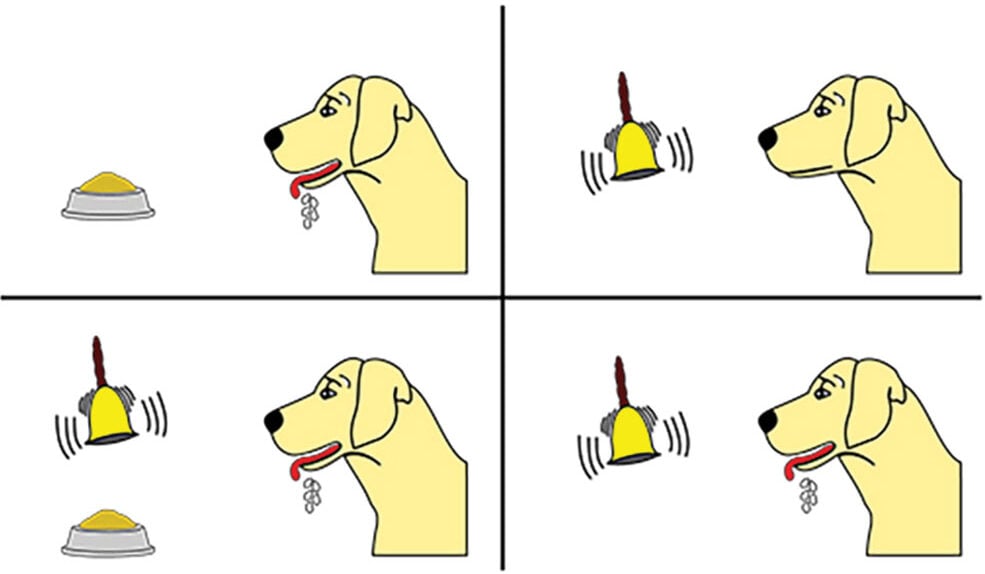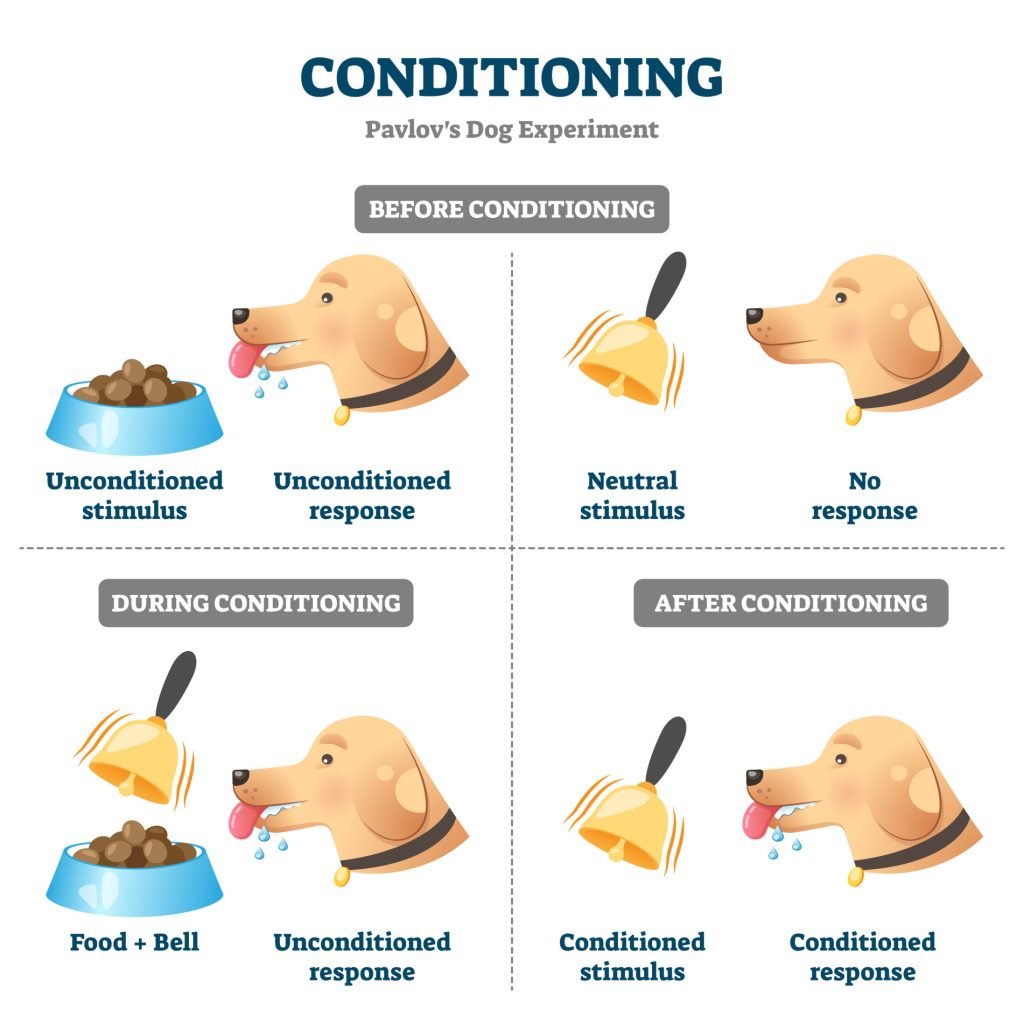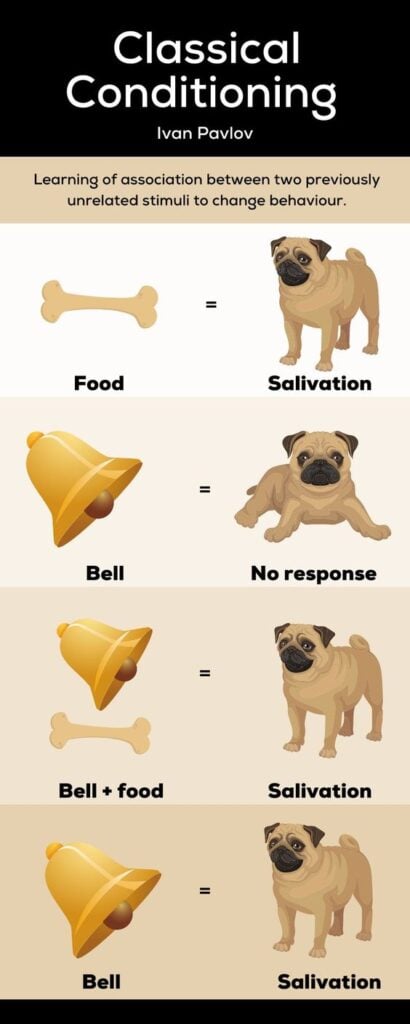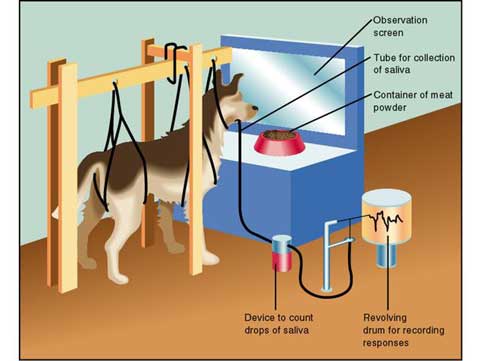On This Page:

Like many great scientific advances, Pavlovian conditioning (aka classical conditioning) was discovered accidentally. Ivan Petrovich Pavlov (1849–1936) was a physiologist, not a psychologist.
During the 1890s, Pavlov researched salivation in dogs in response to being fed. He inserted a small test tube into the cheek of each dog to measure saliva when the dogs were fed (with a powder made from meat).
Pavlov predicted the dogs would salivate in response to the food in front of them, but he noticed that his dogs would begin to salivate whenever they heard the footsteps of his assistant, who was bringing them the food.
When Pavlov discovered that any object or event that the dogs learned to associate with food (such as the lab assistant) would trigger the same response, he realized that he had made an important scientific discovery.
Accordingly, he devoted the rest of his career to studying this type of learning.
Pavlovian Conditioning: Theory of Learning
Pavlov’s theory of learning, known as classical conditioning, or Pavlovian conditioning, posits that behaviors can be learned through the association between different stimuli.
Classical conditioning (later developed by Watson, in 1913) involves learning to associate an unconditioned stimulus that already brings about a particular response (i.e., a reflex) with a new (conditioned) stimulus, so that the new stimulus brings about the same response.
Pavlov developed some rather unfriendly technical terms to describe this process:
- Neutral Stimulus (NS): A stimulus that initially does not elicit a particular response or reflex action. In other words, before any conditioning takes place, the neutral stimulus has no effect on the behavior or physiological response of interest. For example, in Pavlov’s experiment, the sound of a metronome was a neutral stimulus initially, as it did not cause the dogs to salivate.
- Unconditioned Stimulus (UCS): This is a stimulus that naturally and automatically triggers a response without any learning needed. In Pavlov’s experiment, the food was the unconditioned stimulus as it automatically induced salivation in the dogs.
- Conditioned Stimulus (CS): This is a previously neutral stimulus that, after being repeatedly associated with an unconditioned stimulus, comes to trigger a conditioned response. For instance, in Pavlov’s experiment, the metronome became a conditioned stimulus when the dogs learned to associate it with food.
- Conditioned Response (CR): This is a learned response to the conditioned stimulus. It typically resembles the unconditioned response but is triggered by the conditioned stimulus instead of the unconditioned stimulus. In Pavlov’s experiment, salivating in response to the metronome was the conditioned response.
- Unconditioned Response (UR): This is an automatic, innate reaction to an unconditioned stimulus. It does not require any learning. In Pavlov’s experiment, the dogs’ automatic salivation in response to the food is an example of an unconditioned response.
Pavlov’s Dog Experiment
Pavlov (1902) started from the idea that there are some things that a dog does not need to learn. For example, dogs don’t learn to salivate whenever they see food. This reflex is ‘hard-wired’ into the dog.
Pavlov showed that dogs could be conditioned to salivate at the sound of a bell if that sound was repeatedly presented at the same time that they were given food.
Pavlov and his studies of classical conditioning have become famous since his early work between 1890-1930. Classical conditioning is “classical” in that it is the first systematic study of the basic laws of learning (also known as conditioning).
Pavlov’s dogs were individually situated in secluded environments, secured within harnesses. A food bowl was positioned before them, and a device was employed to gauge the frequency of their salivary gland secretions.
The data from these measurements were systematically recorded onto a rotating drum, allowing Pavlov to meticulously monitor the rates of salivation throughout the course of the experiments.
First, the dogs were presented with the food, and they salivated. The food was the unconditioned stimulus and salivation was an unconditioned (innate) response. (i.e., a stimulus-response connection that required no learning).
Unconditioned Stimulus (Food) > Unconditioned Response (Salivate)
In his experiment, Pavlov used a metronome as his neutral stimulus. By itself, the metronome did not elicit a response from the dogs.
Neutral Stimulus (Metronome) > No Response
Next, Pavlov began the conditioning procedure, whereby the clicking metronome was introduced just before he gave food to his dogs. After a number of repeats (trials) of this procedure, he presented the metronome on its own.
As you might expect, the sound of the clicking metronome on its own now caused an increase in salivation.
Conditioned Stimulus (Metronome) > Conditioned Response (Salivate)
So the dog had learned an association between the metronome and the food and a new behavior had been learned.
Because this response was learned (or conditioned), it is called a conditioned response (and also known as a Pavlovian response). The neutral stimulus has become a conditioned stimulus.

Temporal contiguity
Pavlov found that for associations to be made, the two stimuli had to be presented close together in time (such as a bell).
He called this the law of temporal contiguity. If the time between the conditioned stimulus (bell) and the unconditioned stimulus (food) is too great, then learning will not occur.
‘Unconditioning’ through experimental extinction
In extinction, the conditioned stimulus (the bell) is repeatedly presented without the unconditioned stimulus (the food).
Over time, the dog stops associating the sound of the bell with the food, and the conditioned response (salivation) weakens and eventually disappears.
In other words, the conditioned response is “unconditioned” or “extinguished.”
Spontaneous recovery
Pavlov noted the occurrence of “spontaneous recovery,” where the conditioned response can briefly reappear when the conditioned stimulus is presented after a rest period, even though the response has been extinguished.
This discovery added to the understanding of conditioning and extinction, indicating that these learned associations, while they can fade, are not completely forgotten.
Generalization
The principle of generalization suggests that after a subject has been conditioned to respond in a certain way to a specific stimulus, the subject will also respond in a similar manner to stimuli that are similar to the original one.
In Pavlov’s famous experiments with dogs, he found that after conditioning dogs to salivate at the sound of a bell (which was paired with food), the dogs would also salivate in response to similar sounds, like a buzzer.
This demonstrated the principle of generalization in classical conditioning.
However, the response tends to be more pronounced when the new stimulus closely resembles the original one used in conditioning.
This relationship between the similarity of the stimulus and the strength of the response is known as the generalization gradient.
This principle has been exemplified in research, including a study conducted by Meulders and colleagues in 2013.
Impact of Pavlov’s Research
Ivan Pavlov’s key contribution to psychology was the discovery of classical conditioning, demonstrating how learned associations between stimuli can influence behavior.
His work laid the foundation for behaviorism, influenced therapeutic techniques, and informed our understanding of learning and memory processes.
-
Behaviorism: Pavlov’s work laid the foundation for behaviorism, a major school of thought in psychology. The principles of classical conditioning have been used to explain a wide range of behaviors, from phobias to food aversions.
-
Therapy Techniques: Techniques based on classical conditioning, such as systematic desensitization and exposure therapy, have been developed to treat a variety of psychological disorders, including phobias and post-traumatic stress disorder (PTSD).
In these therapies, a conditioned response (such as fear) can be gradually “unlearned” by changing the association between a specific stimulus and its response.
- Little Albert Experiment: The Little Albert experiment, conducted by John B. Watson in 1920, demonstrated that emotional responses could be classically conditioned in humans. A young child, “Little Albert,” was conditioned to fear a white rat, which generalized to similar objects.
-
Educational Strategies: Educational strategies, like repetitive learning and rote memorization, can be seen as applications of the principles of classical conditioning. The repeated association between stimulus and response can help to reinforce learning.
-
Marketing and Advertising: Principles from Pavlov’s conditioning experiments are often used in advertising to build brand recognition and positive associations.
For instance, a brand may pair its product with appealing stimuli (like enjoyable music or attractive visuals) to create a positive emotional response in consumers, who then associate the product with it.
Critical Evaluation
Pavlovian conditioning is traditionally described as learning an association between a neutral conditioned stimulus (CS) and an unconditioned stimulus (US), such that the CS comes to elicit a conditioned response (CR). This fits many lab studies but misses the adaptive function of conditioning (Domjan, 2005).
From a functional perspective, conditioning likely evolves to help organisms effectively interact with biologically important unconditioned stimuli (US) in their natural environment.
For conditioning to happen naturally, the conditioned stimulus (CS) can’t be arbitrary, but must have a real ecological relationship to the US as a precursor or feature of the US object.
Pavlovian conditioning prepares organisms for important biological events by conditioning compensatory responses that improve the organism’s ability to cope.
The critical behavior change from conditioning may not be conditioned responses (CRs), but rather conditioned modifications of unconditioned responses (URs) to the US that improve the organism’s interactions with it.
Evidence shows conditioning occurs readily with naturalistic CSs, like tastes before illness, infant cues before nursing, prey sights before attack. This conditioning is more robust and resistant to effects like blocking.
Traditional descriptions of Pavlovian conditioning as simply the acquired ability of one stimulus to evoke the original response to another stimulus paired with it are inadequate and misleading (Rescorla, 1988).
New research shows conditioning is actually about learning relationships between events, which allows organisms to build mental representations of their environment.
Just pairing stimuli together doesn’t necessarily cause conditioning. It depends on whether one stimulus gives information about the other.
Conditioning rapidly encodes relations among a broad range of stimuli, not just between a neutral stimulus and one eliciting a response. The learned associations allow complex representations of the world.
Recently, Honey et al. (2020, 2022) presented simulations using an alternative model called HeiDI that accounts for Rescorla’s findings. HeiDI differs by allowing reciprocal CS-US and US-CS associations. It uses consistent learning rules applied to all stimulus pairs.
The simulations suggest HeiDI explains Rescorla’s results via two mechanisms:
- Changes in US-CS associations during compound conditioning, allowing greater change in some US-CS links
- Indirect influences of CS-CS associations enabling compounds to recruit associative strength from absent stimuli
HeiDI integrates various conditioning phenomena and retains key Rescorla-Wagner insights about surprise driving learning. However, it moves beyond the limitations of Rescorla-Wagner by providing a framework to address how learning translates into performance.
HeiDI refers to the authors of the model (Honey, Dwyer, Iliescu) as well as highlighting a key feature of the model – the bidirectional or reciprocal associations it proposes between conditioned stimuli and unconditioned stimuli.
H – Honey (the lead author’s surname), ei – Bidirectional (referring to the reciprocal associations), D – Dwyer (the second author’s surname), I – Iliescu (the third author’s surname).
References
- Domjan, M. (2005). Pavlovian conditioning: A functional perspective. Annu. Rev. Psychol., 56, 179-206.
- Honey, R.C., Dwyer, D.M., & Iliescu, A.F. (2020a). HeiDI: A model for Pavlovian learning and performance with reciprocal associations. Psychological Review, 127, 829-852.
- Honey, R. C., Dwyer, D. M., & Iliescu, A. F. (2022). Associative change in Pavlovian conditioning: A reappraisal. Journal of Experimental Psychology: Animal Learning and Cognition.
- Meulders A, Vandebroek, N. Vervliet, B. and Vlaeyen, J.W.S. (2013). Generalization Gradients in Cued and Contextual Pain-Related Fear: An Experimental Study in Health Participants. Frontiers in Human Neuroscience, 7(345). 1-12.
- Pavlov, I. P. (1897/1902). The work of the digestive glands. London: Griffin.
- Pavlov, I. P. (1928). Lectures on conditioned reflexes. (Translated by W.H. Gantt) London: Allen and Unwin.
- Pavlov, I. P. (1927). Conditioned Reflexes: An Investigation of the Physiological Activity of the Cerebral Cortex. Translated and edited by Anrep, GV (Oxford University Press, London, 1927).
- Rescorla, R. A. (1988). Pavlovian conditioning: It’s not what you think it is. American Psychologist, 43(3), 151.
- Pavlov, I. P. (1955). Selected works. Moscow: Foreign Languages Publishing House.
- Watson, J.B. (1913). Psychology as the behaviorist Views It. Psychological Review, 20, 158-177.
- Watson, J. B., & Rayner, R. (1920). Conditioned emotional reactions. Journal of experimental psychology, 3(1), 1.
What was the main point of Ivan Pavlov’s experiment with dogs?
The main point of Ivan Pavlov’s experiment with dogs was to study and demonstrate the concept of classical conditioning.
Pavlov showed that dogs could be conditioned to associate a neutral stimulus (such as a bell) with a reflexive response (such as salivation) by repeatedly pairing the two stimuli together.
This experiment highlighted the learning process through the association of stimuli and laid the foundation for understanding how behaviors can be modified through conditioning.
What is Pavlovian response?
The Pavlovian response, also known as a conditioned response, refers to a learned, automatic, and involuntary response elicited by a previously neutral stimulus through classical conditioning. It is a key concept in Pavlov’s experiments, where dogs learned to salivate in response to a bell.
When did Pavlov discover classical conditioning?
Ivan Pavlov discovered classical conditioning during his dog experiments in the late 1890s and early 1900s. His seminal work on classical conditioning, often called Pavlovian conditioning, laid the foundation for our understanding of associative learning and its role in behavior modification.


BSc (Hons) Psychology, MSc Psychology of Education
Associate Editor for Simply Psychology
Olivia Guy-Evans is a writer and associate editor for Simply Psychology. She has previously worked in healthcare and educational sectors.

Saul Mcleod, Ph.D., is a qualified psychology teacher with over 18 years experience of working in further and higher education. He has been published in peer-reviewed journals, including the Journal of Clinical Psychology.
